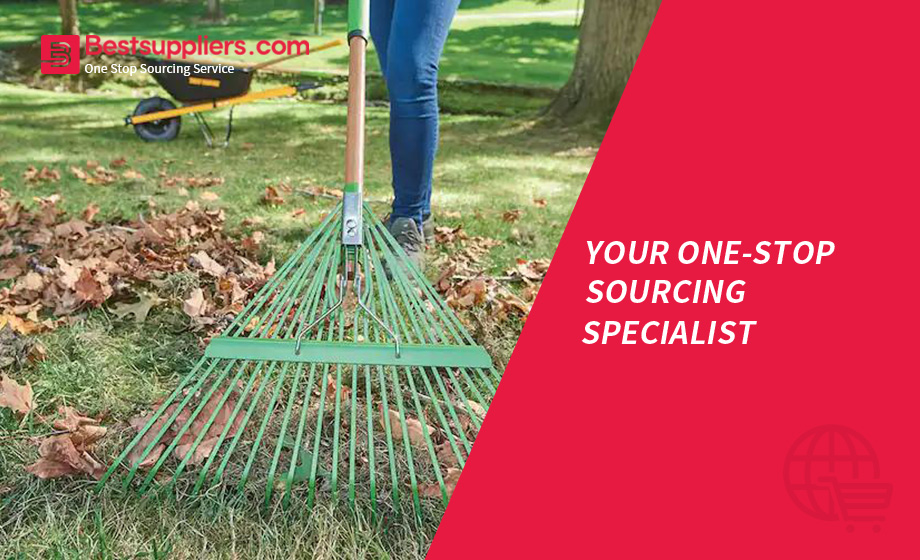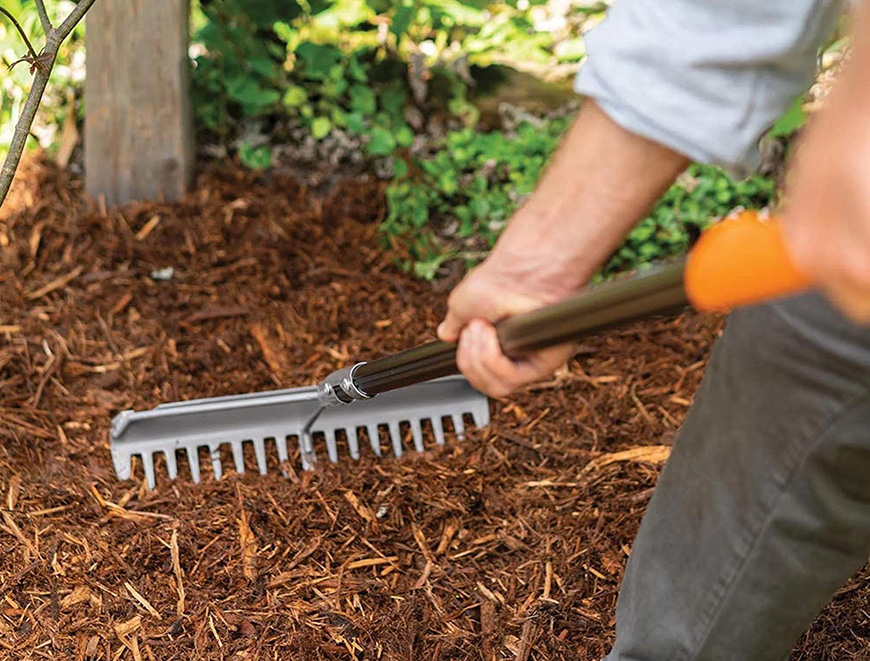Choose The Right Rake for Your Outdoor Jobs

If you want to improve the aesthetics of your garden, a rake can be your best Horticulture & Gardening Tool. Rakes are made of different materials, each with its advantages and uses. There are many types of rakes, and unless you own a large landscaping company, you won't be dealing with many types of rakes. When you're going to a hardware store, in the garden tool section trying to choose a rake can be overwhelming, so how do you choose? Let's learn what these different types of rakes are designed for.
Parts of Rakes
Common rakes are composed of three important parts, including the rake head, rake handle, and rake tines & teeth. Besides traditional plastic and metal, rakes are available in various material constructions to suit different tasks and market prices.

Rake Head
The purpose of a rake can be seen in the construction of the rake head. Lightweight narrow heads made of plastic are used for lightweight materials such as loose leaves and fluffy snow, while wide metal heads are often used for garden rakes and are designed for multipurpose use.

Rake Handle
These can be made of wood, metal, plastic, or alloy materials. Lightweight plastic or aluminum long-handled rakes are preferred to reduce the weight of the rake and thus reduce user fatigue. Commercial and heavy-duty rakes feature thick steel heads designed for heavy-duty and durability at the expense of weight and cost.

Rake Tines
Lightweight rakes are typically made using: plastic, fiberglass, thin metal, wood, or bamboo (for traditional or eco-friendly designs). Lawn and multipurpose rakes Use: Aluminum, light metals, plastics, composites (polymers + metals)
Heavy gauge rakes are made of heavy gauge metal and steel.

6 Rake Types for Your Backyard
In the rake categories, not all rake types are used to collect fallen leaves. Some are for laying stones in gardens or parks, while others are for loosening the soil in preparation for planting. Some are even designed to clear ponds or remove snow from roads. Depending on the project, there may be a rake that speeds up or simplifies the task at hand.
1. Lawn rake
Many gardeners use them in the backyard. Lawn rakes have a similar shape to leaf rakes and are often mistaken. A lawn rake has a long, straight handle and a head with slender metal tines whose edges are bent at about 90 degrees and spread out to form a fan shape. The same distance is maintained between each metal tine. These rakes excel at sweeping up fallen leaves and lawn debris and do a good job of dragging debris from under large trees and large plants without penetrating or damaging the underlying grass or soil. If it is just to remove light debris such as fallen leaves, plastic leaf rakes can do the job. Its price is much cheaper than metal leaf rakes, and the quality of plastic rakes is much better than we think.

2. Garden Rake
Garden rakes have many similarities in design to leaf rakes, and garden rakes are more versatile. The tines of this kind of rake are wide and short, usually only about 3 inches (7.5 cm) long. These tines have a strong rigidity. These rakes are usually used for more difficult jobs such as loosening and moving compacted soil. Its sturdy structure Enables it to rake up material heavier than fallen leaves such as gravel etc. Garden rakes are almost always made of metal and are sometimes called iron rakes or leveling head rakes by gardeners.

3. Shrub Rake
The tines on the head of the shrub rake are shorter and fewer in number. The smaller head scallop has the advantage of allowing the bush rake to get into smaller spaces. It is ideal for raking debris from side fences or between and under bushes, hence the name bush rake. Generally, shrub rakes can be divided into metal shrub rakes or plastic shrub rakes according to the material.
4. Hand Rake
This is a small handheld rake, a scaled-down version of other rakes, about the size of a fist. The design of the hand rake head is not much different from other rakes. Hand rakes are usually used on flower pots and flower beds. This Horticulture & Gardening Products allows gardeners to observe the growth of plants at a closer distance. It is very suitable for digging and moving soil in a small area and can assist gardeners in better cleaning up small plants. Weeds or debris underneath. These rakes usually have a metal head and a wooden handle, the material of which is designed to be more comfortable for the user.

5. Electric Rake & Power Rake
This rake removes debris from your lawn while digging up thatch for a quick finish on your lawn finish. The operation is also very simple, all the gardener needs to do is to push it into the lawn that needs to be cleared, and The remaining work is done by the engine without extra force, which can relieve wrist fatigue. There are two kinds of power rakes: wired and wireless. In the case of short working hours, we can choose a wireless power rake, which does not need to find a plug to start it. A power rake features a rotating head with metal tines that dig deep into the existing lawn, prying up fallen leaves, small twigs, and thick weeds.

6. Roof Rake
What is the rake of a roof? Roof rakes are commonly used to remove snow from roofs. Having a roof rake is a necessity for some people who live in snowy regions and countries. The accumulation of snow to a certain extent will affect the shape of the roof, and it may cause danger when it slides down. The overall weight of the roof rake is very light, but it does not mean that it is not strong, and it saves a lot of effort for light-clearing snow workers. The teeth on the head of the rake are not sharp because snow is a fluffy object and does not need sharp tines to clear it.

Metal Rake vs Plastic Rake
Plastic heads on rakes can be both good and bad, depending on what you want to do with them. Some types of rakes only fit plastic heads, such as roof rakes. Because these need to be light in weight, you can guarantee safety when using them on the head, even if you hit your head, there will be no big damage. On the other hand, it will protect the roof surface, even if the roof is scratched There is also no damage to the roof structure.
Metal-headed rakes are a little more expensive than plastic rakes, but they last longer, so metal-headed rakes become more cost-effective based on the time we use them. The metal head on the rake won't snap or split like plastic, allowing it to rake larger or heavier items. Metal heads on rakes are also more versatile than plastic-headed rakes, which are only good for light objects like leaves or snow. Metal tines can handle a wider variety of items, such as gravel, cement, shrub leaves, and other heavier items. The main disadvantage of metal rakes is that the head of the metal rake is relatively sharp. When it comes to leaf rakes, the metal rake will pierce the leaves and make the leaves attached to the head of the rake. It takes a certain amount of time to clean the leaves on the metal rake head. Makes your rake work less efficiently.

Frequently Asked Questions About Types of Rakes

1. Which rake is best for dead grass?
The most efficient way to remove dead grass is with an electric rake. Grass rakes and garden rakes are also great options for removing dead grass that accumulates on your lawn.
2. What is the use of a rake?
Types of rakes are designed for single use to increase productivity, while increasing the life of the rake, such as roof rakes, and hay rakes. While other types of rakes can be used for multiple tasks in the garden.
3. How many types of rakes are in daily life?
There are currently over a hundred rakes in production.
4. How long are the standard rake tools?
The average length of a rake is between 22 and 30 inches, not including hand rakes. When sourcing rakes, be sure to determine the size in advance, as the size will determine the ease of use of the rake tool. A good purchasing tip is to choose an inside-to-mouth length.
If you have other questions about rakes, you can also contact us directly, we will try our best to give you the correct answer.
Final Thoughts
Rakes come in a variety of sizes and shapes and are manufactured from different materials, including metal rakes, plastic rakes, and bamboo rakes. Most yarders and gardeners only need a few different types of rakes to get by. For those dealing with special projects, other hand tools are required to assist in the completion.
We provide customized rakes in different sizes, materials, and quantities. We have rake orders for reproduction every day, so we have the latest rake factory direct ex-factory prices. If you need to purchase any styles of rakes, please contact us immediately.

